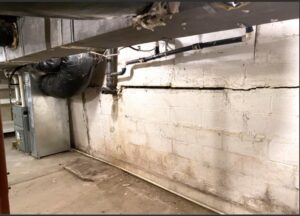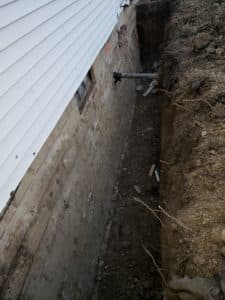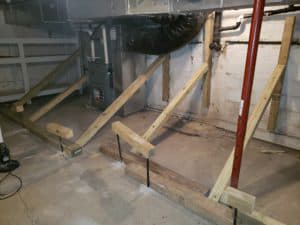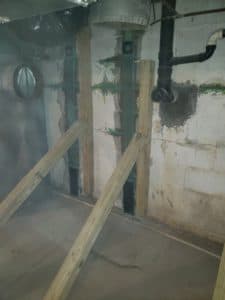How to Straighten a Bowed Foundation Wall

Originally posted 1/7/21; updated 7/31/23
If you’ve read any of our other blogs about tilting foundation walls, you know that repairing a bowed basement wall does not have to include straightening it. In many cases, stabilizing and securing the wall is all that’s required to restore your foundation’s stability.
For many homeowners, the goal of the repair is only to remedy the damaged walls and restore their foundation’s health. That’s because basement wall straightening adds to the overall expense. If you’re only using your basement for storage, why not save money for use in more visible spaces?
However, if you want to convert your basement into a living space, feel uneasy about a tilting foundation, or you’re concerned the wall will look unsafe despite repairs, what should you do? It is absolutely possible to straighten it.
 This photo was taken by an Acculevel project advisor during an in-home evaluation. This wall is showing signs of a wall buckling under pressure.
This photo was taken by an Acculevel project advisor during an in-home evaluation. This wall is showing signs of a wall buckling under pressure.
Acculevel is a family-owned company that has specialized in foundation repair and waterproofing since 1996. We understand that our customers want to be budget-conscious, but we also know your home is often your largest investment. Restoring stability to your foundation is essential. But you may also want to improve your resale value by having a basement that both is and looks strong and healthy.
In this article, we’ll explain what causes a buckling basement wall, review the steps to wall straightening, provide approximate costs, and explain why a bowed wall still needs to be secured after it’s been straightened.
Why Is This Basement Wall Bowing?
When a foundation wall starts to bow or lean inward, the most likely cause is hydrostatic pressure. When it rains, the ground absorbs it —to a point. If there is more moisture in the soil than it can absorb, the excess water is free to push against anything in its path — including your basement walls.
Over time, this lateral pressure will create cracks, and that’s when the bowing will start. In the photo below, you can clearly see the long horizontal crack that formed from hydrostatic pressure.
FYI: The following photos are from the same home, and were taken by Acculevel employees during the repair process.
 This photo was taken by the project advisor, before the repairs were made.
This photo was taken by the project advisor, before the repairs were made.
Straightening Tilting Foundation Walls is a Multi-Step Process
Before we can push the tilting basement wall back into position, we need to relieve the pressure on the bowed basement wall. Trying to force the wall back into a straight alignment without addressing the pressure will increase the foundation damage.
Use Hydraulic Jacks to Stabilize Your Home
The first step is to protect the structural integrity of your home. We install temporary floor jacks under the floor joists and beams that support your floors. Essentially, we’re transferring the responsibility of holding up that side of the house off of the bowing basement wall onto the jacks.
Excavate the Exterior of the Basement Wall
Once we don’t have to rely on the damaged foundation wall to hold up your house, we can remove the soil outside the bowing wall. This will relieve pressure on the wall, while also giving it room to move back into place.

The soil is removed down all along the damaged wall. You can see it’s still leaning inward at this point in the process.(The visible pipe is the sewer line, FYI.)
The Wall is Straightened and Temporarily Reinforced
Now the wall can be gradually pushed back into place and held there. To accomplish this, steel rebar is drilled into the floor. This rebar works as the anchor for the wooden braces that are used to straighten and support the wall.
Wall straightening costs $175-$200 per linear foot. If the wall is 24 feet long, that would be a price range between $4200-$4800. This price does not include the carbon fiber straps that you’ll need to reinforce the wall and prevent future movement. (We explain the need for reinforcement next.)
 This is a view of the supporting jacks, rebar, and wooden braces.
This is a view of the supporting jacks, rebar, and wooden braces.
Bowing or Buckling Walls Must Be Reinforced
Straightening a wall does not repair it; it only returns the wall to its original position. If this wall has bowed once, it’s likely to do so again in the future. Think of the bowed wall like a badly broken bone. In this metaphor, straightening the wall is resetting the bone, and the straps are the cast. The difference is that a bone will re-grow and heal, allowing the cast to be removed. Your wall won’t renew itself, so reinforcement is part of the permanent solution.
Carbon Fiber Straps Are Ideal for Bowed Basement Walls
Carbon fiber straps are the least expensive and the least invasive method to stabilize bowing walls. The straps Acculevel installs are manufactured by Fortress Stabilization Systems and are backed by a life-of-structure warranty. If the wall is bowing less than 2 inches, straps alone can be installed to effectively restore stability to the foundation.

These are close-up pictures of a carbon fiber strap, showing how it’s fastened at the top and bottom. To secure the bottom of the strap to the footing, we broke up a small section of the floor
You can see in the photos above that each strap is secured at the top of the wall (attached to the band joist). There’s another anchor at the bottom, affixed to the foundation footing. The straps are sealed to the wall with specially designed epoxy (seen here in green, it also comes in gray).
Why Did We Need a Helical Tieback?
We mentioned above that a wall bowing two inches can be repaired with straps. So why did we add a tieback on this project?
This portion of the basement wall was concerning, as the damage caused also disrupted the stairway built directly against it. To add additional stability, we determined an additional support here was warranted.
Either a wall anchor system or helical tiebacks would have worked for this particular wall repair. However, we chose a helical steel tieback because of the location of the home on the property. You can’t install wall anchors if there isn’t sufficient clearance outside the wall (the anchor needs to be buried 10 feet into the yard).

This is the inside view of the tieback under the stairs. Jacks and bracing were also needed on this side of the basement wall.
Bracing is Essential Until the Epoxy Cures
This last photo shows the completed wall repair. The excavation outside the wall has been carefully refilled; the soil is returned to fill the trench, but not packed down. We want the soil to gradually settle so that it doesn’t unduly stress the formerly bowing basement.

The bracing will be taken down once the straps have “cured.”
You will notice the rebar and braces are still in place. Until the straps are completely set, we will leave these items installed. The carbon fiber straps require at least 24 hours to fully cure and set. After a few days, we will return to the job site to remove the bracing and repair the holes we made in the concrete. At that point, the homeowner can paint over the straps if they like, using regular indoor house paint.
Bowing Basement Walls Are a Serious Threat
At the beginning of this article, we showed you a basement wall that was forming cracks in a very specific pattern. In poured concrete walls, this is a long horizontal crack. In block foundations, the crack can also be a stair-step (or zig-zag) shape that follows the mortar lines.
If you see either of these cracks in your foundation walls, please contact your local foundation repair expert for evaluation. Left unchecked, these cracks will only get worse — and more expensive for you to repair.
Please Do Not DIY Foundation Repairs
We understand that some homeowners are very handy and capable of home repairs, and we’re not trying to disparage your skills! But your entire house is literally resting on its foundation; any damage done to it can have terrible consequences for your home.
We believe Fortress has the best carbon fiber straps in the industry — that’s why we install them exclusively. You have to be licensed to use their products in installation and they’re guaranteed by the best warranty in the business (life of structure, when installed properly). They won’t sell to a private homeowner, and none of the alternatives available to you are going to be of similar quality.
Additionally, your insurance company may not cover an amateur installation, given the risks of structural damage. And it will certainly be flagged by a home inspector when it comes time to sell your home. So please, leave such critically important foundation repairs to the pros.
Do You Have a Bowing Basement Wall That Needs Repair?
If you live in Indiana or the surrounding states, please contact Acculevel. We are foundation repair experts and have been providing permanent solutions to basement and foundation damage since 1996.
We’ll schedule an appointment for you with one of our knowledgeable project advisors. They will evaluate your home, review the options with you, and provide a free written estimate.
If you don’t live in our service area, please check the resources near you, and verify the company is reputable, insured, and accredited by the Better Business Bureau.
Not sure how to hire a contractor, or what to ask? You can use our free detailed checklist of questions you should ask a contractor to help you make the right choice for you.
